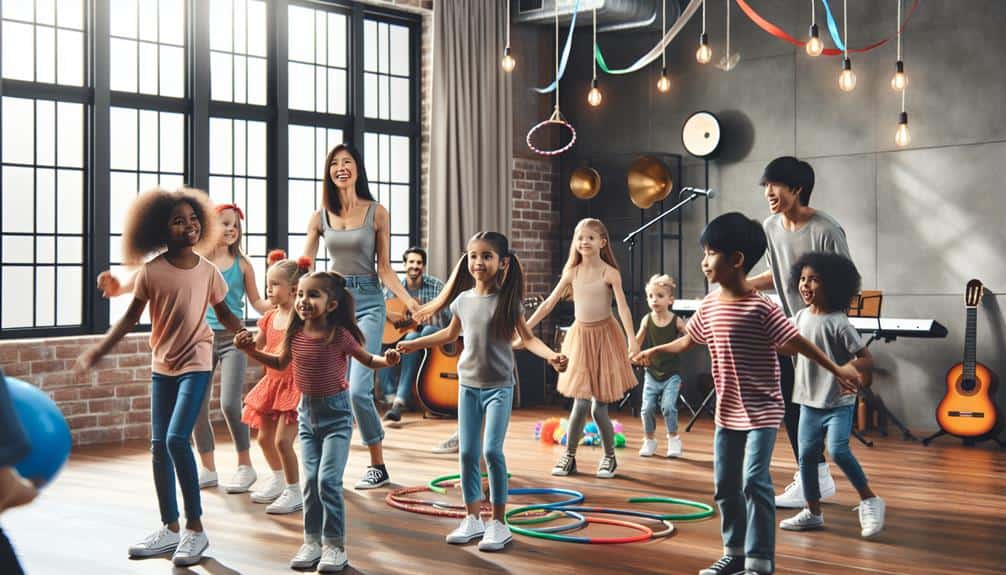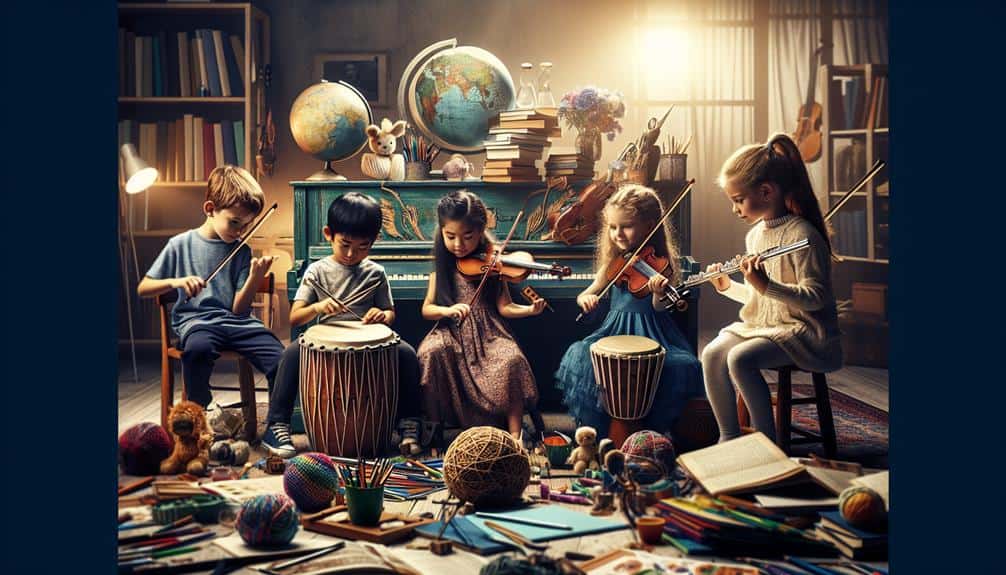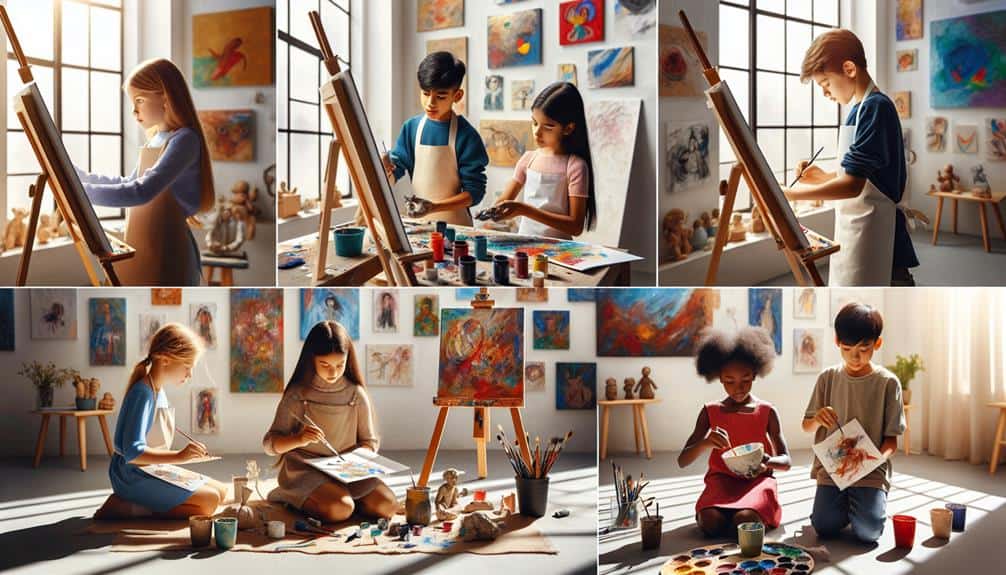Elevate your homeschooling experience by incorporating dance lessons. Enhance coordination, fitness, and creativity. Customize styles to your child's interests – jazz, ballet, hip hop, and more are ready for exploration. Establish a dance schedule for monitoring progress. Fuse dance with academics for kinesthetic and interdisciplinary learning. Set attainable goals, dividing them into smaller targets for motivation. Display skills uniquely, infusing routines with passion and precision. Harness the power of movement to enhance your child's education.
Key Points
- Choose dance styles aligned with children's interests and personalities.
- Create a dance calendar with clear goals for progress tracking.
- Integrate dance with academic subjects for interdisciplinary learning.
- Set specific and achievable goals for dance practice.
- Showcase dance skills creatively through innovative choreography.
Benefits of Including Dance Lessons
Including dance lessons in your homeschool curriculum can provide numerous benefits for your child's physical, emotional, and cognitive development. Through dance, your child can experience a range of physical benefits such as improved coordination, flexibility, and strength. Moving to the rhythm helps in enhancing muscle tone and overall fitness levels, promoting a healthy and active lifestyle.
Emotionally, dance offers an important outlet for self-expression, allowing your child to convey their feelings and creativity through movement. It can boost self-esteem and confidence as they master new steps and routines, fostering a sense of accomplishment and pride. Additionally, the emotional release that comes with dancing can help reduce stress and anxiety, promoting overall emotional well-being.
Furthermore, dance lessons provide an excellent opportunity for your child to develop crucial social skills. Working with peers in a group setting encourages teamwork, communication, and cooperation. It helps in building friendships and a sense of community, nurturing important social connections.
Choosing the Right Dance Style
When selecting the perfect dance style for your homeschool curriculum, consider the unique interests and personalities of your children. Age-appropriate choices will guarantee that they engage fully and enjoy the learning process.
Let's explore how different dance styles can cater to various preferences and developmental stages.
Dance Style Considerations
Exploring the diverse world of dance styles to find the perfect match that resonates with your unique interests and aspirations is crucial.
When considering jazz versus ballet, think about the elegance and grace of ballet contrasted with the energetic and expressive movements of jazz. Ballet focuses on technique, precision, and storytelling through fluid movements, while jazz incorporates syncopated rhythms, isolations, and a more contemporary feel.
On the other hand, if you're drawn to the vibrant and dynamic nature of urban culture, hip hop options might be the way to go. Hip hop encompasses a wide range of styles, from breaking and locking to popping and krumping, allowing for self-expression, creativity, and physicality.
Each dance style offers a distinct experience, and selecting one that aligns with your personality and goals is crucial. Whether you prefer the structured discipline of ballet, the improvisational freedom of jazz, or the urban flair of hip hop, choosing the right dance style will enhance your homeschool curriculum with artistry, physical activity, and cultural exploration.
Age-Appropriate Choices
Consider the developmental stage and interests of your child when selecting a dance style for their homeschool curriculum. Choosing the right dance class can make all the difference in their engagement and enjoyment.
For younger children, movement games and activities that focus on creative expression can be particularly beneficial. These classes often incorporate fun activities that encourage children to explore different ways of moving their bodies while fostering their imagination.
As children grow older, their interests and abilities may change, leading to a natural progression towards more structured dance styles. For example, ballet can provide a strong foundation in technique and discipline, while hip-hop may appeal to those who enjoy a more upbeat and urban style of dance. Jazz and contemporary dance classes offer a blend of different techniques, allowing students to experiment with various movements and styles.
Scheduling Dance Sessions Effectively
To ensure maximum progress in your dance lessons, strategically plan and schedule your dance sessions with purpose and intention. Time management is vital in ensuring that you allocate sufficient time for dance practice within your weekly routines.
Consider setting aside specific time slots for dance breaks, incorporating them as a form of physical activity that not only nurtures your body but also refreshes your mind. Embrace the joy of movement during these dance sessions, allowing yourself to fully immerse in the rhythms and steps.
- Create a Dance Calendar: Plot out your dance sessions on a calendar to visualize your progress and stay motivated.
- Set Clear Goals: Establish achievable goals for each session to track your improvement and keep you focused.
- Practice Regularly: Consistent practice is key to mastering dance techniques, so commit to regular sessions to enhance your skills effectively.
Integrating Dance With Academic Subjects
Harness the power of dance as a dynamic tool to enhance your homeschool curriculum. Connect the grace of movement to scientific concepts.
Bring math to life through rhythm and patterns. Travel through time with historical dance lessons.
Watch as your academic subjects come alive through the art of dance, sparking creativity and enriching your learning experience.
Dance in Science
Integrating dance with science not only enhances physical movement but also fosters a deeper understanding of scientific concepts through kinesthetic learning experiences. When exploring the intersection of dance and science, you open up a world of creativity and discovery that transcends traditional classroom boundaries. Here's why this fusion is so compelling:
- Motion experiments: Through dance, you can conduct engaging motion experiments that bring scientific principles to life in a dynamic and interactive way.
- Physics of dance: Investigate the physics of dance, exploring concepts like momentum, force, and energy transfer through the graceful movements of dancers.
- Kinesthetic learning: By embodying scientific concepts through dance, learners can internalize and retain knowledge more effectively, making learning a truly immersive experience.
Dance Math Connections
Exploring the mathematical connections within dance can ignite a spark of interdisciplinary learning that elevates both subjects to new heights of understanding and creativity.
When delving into the world of dance math connections, you'll find a fascinating blend of choreography patterns, counting steps, geometric formations, and rhythm analysis that seamlessly intertwine movement with mathematical concepts.
In dance, choreography patterns involve organizing movements in a sequence that often follows mathematical principles. Counting steps not only enhances coordination but also reinforces mathematical skills such as counting, sequencing, and pattern recognition.
Geometric formations within dance routines challenge dancers to understand spatial relationships, symmetry, and angles, translating abstract mathematical concepts into tangible movements.
Rhythm analysis in dance requires dancers to interpret and synchronize with various rhythmic patterns, fostering a deep understanding of fractions, timing, and proportions.
Dance History Lessons
Embark on a captivating exploration through the rich tapestry of dance history, intertwining the art of movement with academic subjects to reveal the cultural and historical significance behind each graceful step.
Immerse yourself in the world of dance history where choreography techniques aren't just sequences of movement but stories told through the body, each step carrying the legacy of generations of dancers.
Uncover the brilliance of famous dancers whose names echo through time, their performances shaping the very essence of dance as it exists today.
Unravel the intricate web of cultural influences that have woven themselves into the fabric of dance, creating a tapestry of diversity and expression. Witness the evolution of dance as it transcends borders, blending traditions and innovations into a mesmerizing display of human creativity.
Feel the passion of dancers as they breathe life into choreography techniques, turning mere steps into a symphony of movement.
Explore the stories behind famous dancers, their struggles, triumphs, and the legacy they leave behind.
Immerse yourself in the cultural influences that have shaped the evolution of dance, tracing its journey through time and across continents.
Setting Goals for Dance Progress
To maximize your dance progress effectively, establish clear and achievable goals that align with your aspirations and skill level. Setting specific goals helps you stay motivated and focused on your improvement journey.
Start by defining what you aim to achieve in your dance practice, whether it's mastering a particular technique, perfecting a routine, or enhancing your overall performance. Break down these larger objectives into smaller, measurable targets to track your improvement and celebrate milestones along the way.
Goal setting is essential for guiding your practice sessions and ensuring steady progress. Evaluate your progress regularly to assess what's working well and where you may need to adjust your approach. Consider creating a dance journal to log your goals, track your development, and reflect on your achievements.
Showcasing Dance Skills Creatively
Crafting mesmerizing performances that showcase your dance skills creatively can elevate your artistry and leave a lasting impression on your audience. To truly captivate your viewers, consider the following:
- Innovative Choreography: Experiment with different styles, music genres, and movement patterns to create a unique dance piece that tells a story and evokes emotions.
- Dynamic Dance Performances: Infuse your routines with energy, passion, and precision. Engage your audience by expressing your personality through every movement.
- Strategic Showcasing: Whether at dance competitions or showcases, strategically plan your performances to highlight your strengths and leave a lasting impact on the judges and spectators.
Frequently Asked Questions
Can Dance Lessons Help With Social Skills Development?
Dance lessons can significantly help with social skills development. Engaging in dance fosters social interaction and boosts confidence. It encourages teamwork and enhances communication skills. Through movement and expression, you can grow in these crucial areas of personal development.
How Can Dance Improve Physical Fitness in Homeschoolers?
Dance routines offer a fun way to boost physical fitness. With lively movements and rhythms, you'll enjoy cardio benefits like improved endurance and heart health. Get grooving and feel the energy flow through your body.
Are There Online Resources for Homeschool Dance Lessons?
Interested in delving into the world of dance from home? Immerse yourself in interactive platforms providing virtual instruction. Uncover a plethora of online resources for homeschool dance lessons, ideal for boosting creativity and physical activity.
Can Dance Lessons Accommodate Children With Special Needs?
Dance lessons can be tailored to accommodate children with special needs. Instructors use adapted techniques and individualized approaches in inclusive classes. These programs provide a supportive environment where every child can thrive and express themselves through movement.
How Can Parents Assess Their Child's Progress in Dance?
To assess your child's progress in dance, actively participate in class observations. Engage with instructors to determine milestones. Attend showcases for performance opportunities. Your involvement fosters growth and confidence in your child's dance journey.



